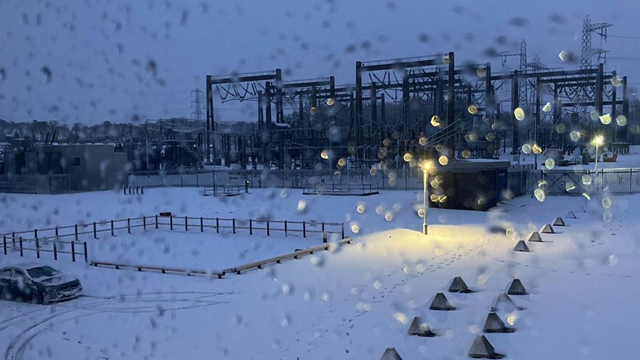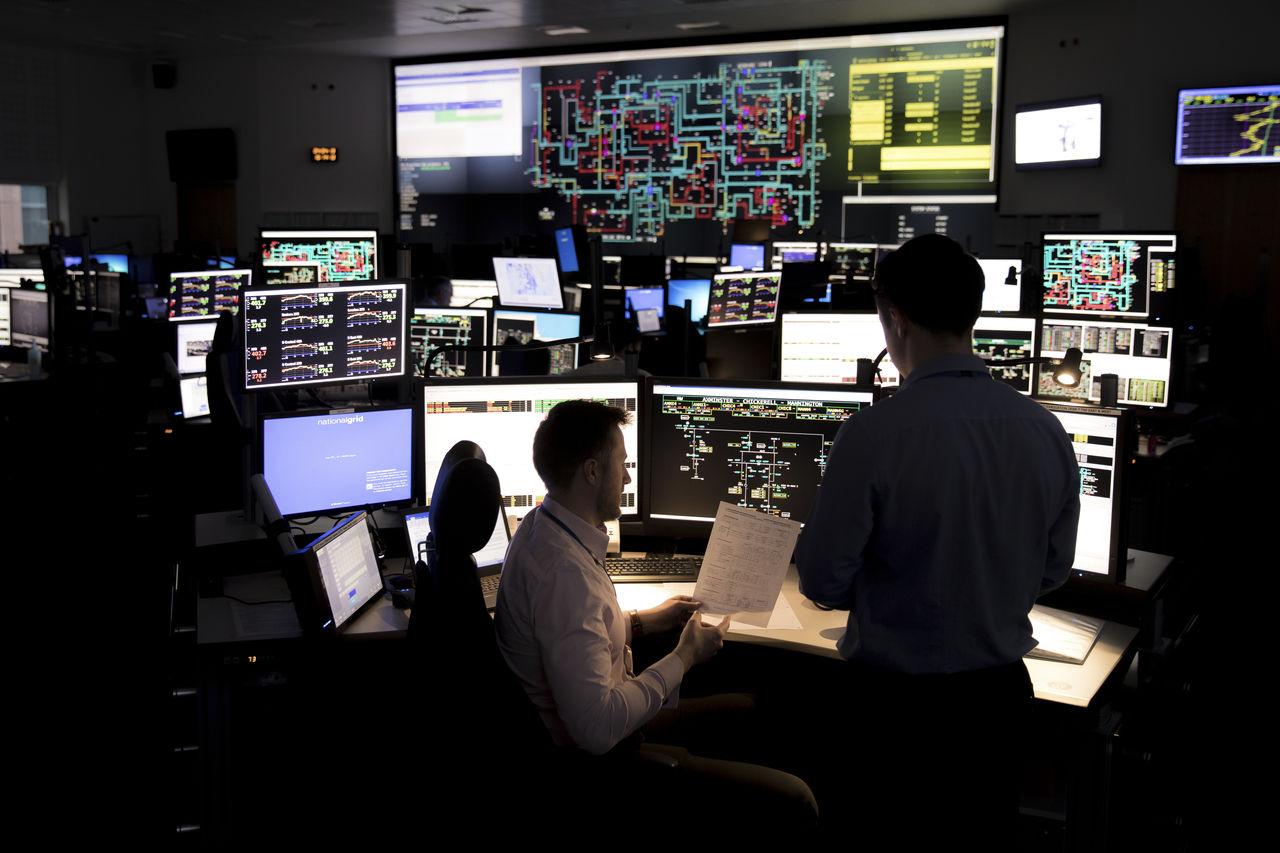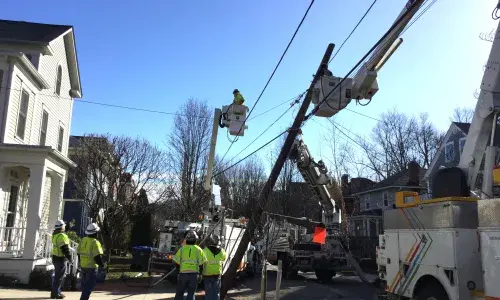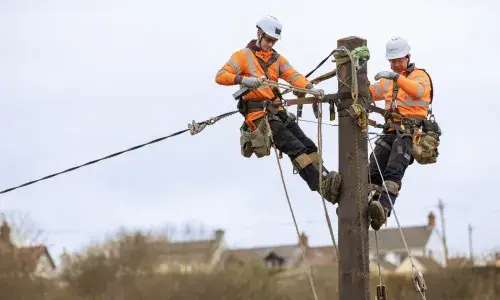
5 ways we keep the electricity network protected from storms
Stormy weather has the potential to cause disruption to our electricity system. As owners of the transmission network in England and Wales, as well as the distribution network in the Midlands, South West England and South Wales, we take the job of ‘keeping the lights on’ very seriously and have a number of measures in place to deal with potential issues that severe weather might cause.
Preparing for a storm
The electricity transmission system is the physical system that we use to move electricity at high voltage across the country; we do a lot of meticulous preparation to guard against power cuts occurring at a national level, and to ensure that electricity continues to flow to reach the local electricity networks.
When planning how we manage the network, our engineers and analysts consider every detail that might impact how electricity is delivered around the country. This means that weather is one of our most important considerations, especially at times of year when we know we’re likely to face inclement or severe weather.
Power cuts on our distribution network – which connects electricity from the transmission network to homes, businesses and vital services – are also more likely during severe weather. So we have additional measures in place during the winter months to ensure we can restore supplies as quickly and safely as possible, as well as enabling customers to get the support and information they need; particularly those in vulnerable situations.
Read more about how we deal with power cuts
How we manage the risks to the electricity system
1. Planning ahead
Our transmission and distribution systems must be resilient to storm conditions, and we work all year round to ensure we’re ready for all kinds of severe weather. This includes:
- upgrading and maintaining equipment, as well as routinely checking the condition of our assets and the environment around them.
- reviewing weather forecasts based on multiple weather prediction models.
- collaborating with other industry parties, such as the National Energy System Operator (NESO) and local Distribution Network Operators (DNOs), to understand our collective resilience and anything we may need to manage together
- evaluating the network status and, if practical, looking to return any assets that may be out for scheduled maintenance earlier than planned to make the network more resilient
- putting plans in place to make sure we can restore power supplies quickly and safely in the event of a power cut.
- putting temporary generators and flood defences on standby, as well as helicopters to help identify badly affected areas and hasten repairs.
- reviewing workforce plans to ensure effective staffing, both in the field and in our control rooms.
- having additional colleagues on standby across all parts of our business, whether that’s operational and engineering staff to respond to network issues, contact centre staff to help customers with enquiries, or colleagues ready to provide IT or other functional support.
- diverting teams and resources away from planned non-essential work in case they’re needed to assist.
2. Engineers in the field
Our engineers and operations teams make sure the network of pylons, cables and substations is robust against weather damage and a wide range of faults.
They respond to issues during the event and follow up at all sites to complete damage assessments.
Find out how we prepare for winter all year round

3. Inside our control room
Our engineers in the field are in constant contact with our control centres, which operate 24 hours a day, 365 days a year.
The Transmission Network Control Centre (TNCC) remotely controls the operations of the high-voltage electricity transmission system in real time. Our transmission teams monitor over 7,000km of overhead line, over 300 substations and over 700km of underground cable, to locate any faults or issues and take appropriate action to ensure that electricity continues to flow.
As well as managing network issues, the TNCC also coordinates with key customers who are connected to our network. TNCC colleagues are also connected to any emergency calls with the wider industry, like Ofgem or the Department for Energy Security and Net Zero (DESNZ), to provide critical network updates and support where needed.
Our Distribution Control Centre looks after our distribution network in the Midlands, South West England and South Wales. On this network we’re responsible for 225,000km of overhead line, 90,000km of underground cable and 188,000 substations to keep the lights on across our four distribution licence areas.
4. Making sure there’s as much network capacity available as possible
The TNCC is also in constant contact with the NESO, who balances supply and demand in the electricity system. Our TNCC engineers will work with NESO’s control room – monitoring the weather and anticipating different scenarios – to make sure as many circuits as possible are in service, maximising the availability and resilience of the network. This might mean rescheduling work to keep parts of the network operating.
5. Responding to network issues
Our transmission network has built-in protection systems to detect faults and trip circuits immediately, clearing the fault and avoiding any issue becoming more serious. This triggers a mechanism called delayed auto reclose (DAR), which kicks in if a circuit trips (not uncommon during bad storms) and switches the powerline back into service after a few seconds. During Storm Arwen in November 2021, around 45 circuits tripped, with protection and DAR operating to clear and restore them quickly.
Our transmission teams also offer to support DNOs at a local level where possible, providing key resources to support them in re-connecting supplies to communities and infrastructure such as hospitals. This may include deploying technical staff or use of our helicopters to identify damage.
As a DNO, we provide extra support for customers on our Priority Services Register, many of whom are in vulnerable situations, in the event of a power cut. During severe weather events, this support is even more vital for these customers, who may be elderly, disabled or medically dependent on electricity. These customers receive regular updates during a power cut and, where appropriate, may be offered support from external agencies, such as the Red Cross.
Find out more about how local electricity networks prepare for storms.
Other contingencies are in place too. For example, colleagues at Thorpe Marsh substation in Doncaster set up 1.5km of temporary flood defences to successfully shield it from unusually severe floods.
Read more about reporting a power cut and safety advice


